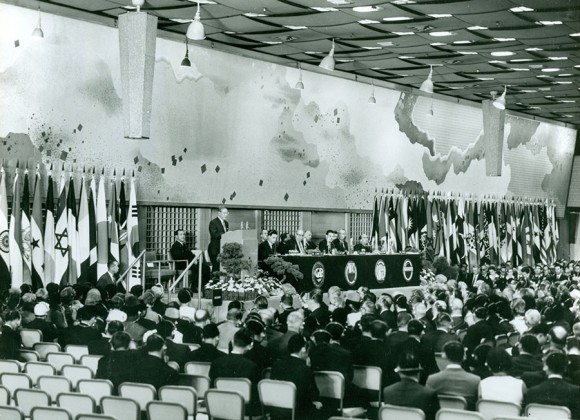The second week of September 1964 saw more than 2,000 delegates from 103 countries come to Tokyo’s Hotel Okura to attend the first World Bank / IMF meetings ever held in East Asia. Back then, Japan was still a recipient of Bank loans and technical cooperation but was soon – and somewhat reluctantly – going to graduate from the ranks of recipient countries.
A pin commemorating the meetings (from World Bank archive)
Just before the 1964 Olympics, the Bank meetings were a great opportunity to demonstrate to the global economic elite what Japan had achieved nineteen years after the end of the war.
Undoubtedly, developing nations (many of them newly independent) were astonished to see the progress. After all, it took “Japan 20 years for what it had taken 80 years before the war”. This was economic catch-up (and leapfrogging) in action.
While less significant from a purely quantitative point of view, World Bank and IMF assistance was very helpful to Japan. Then Japanese prime minister Hayato Ikeda addressed the plenary session:
There have been occasions when financial assistance from the IMF has helped us to solve our balance of payments difficulties. Many times loans from the IBRD and cooperation extended to us by Western financial institutions have covered our capital shortage and helped us to advance our steady economic growth.
The meetings in Hotel Okura’s Heian Room (from World Bank archive), also see the hotel’s website here
Japan became a member of the Bretton Woods institutions in 1952, before it got admitted to the United Nations four years later. Yet it was to take three years before the first loan was made.
Already in the beginning of its cooperation with the international financial institutions (IFI), Japan was structurally different from other developing countries. After all, it was or at least had been an industrial country before the war and could thus rely on a strong bureaucracy as well as an educated workforce.
Eventually, from 1955 until 1966 Japan borrowed a total of $800 million from the Bank (less than 20% of total external borrowing), split across more than thirty individual loans.
The qualitative impact these loans had was arguably more important than the financial contribution to the individual projects.
Take highways: typical of today’s development banking, a report was commissioned and drafted by an external consultant (incidentally, this was to be German ex-Nazi Franz Xaver Dorsch, one of the main architects of the German autobahn network). The report noted that “the roads of Japan are incredibly bad. No other industrial nation has so completely neglected its highway system.”
World Bank technical assistance and its soft loans were to play an important role in the Kobe-Tokyo highway project as well as in the Tokyo metropolitan highway network. A loan to the toll road operator was also to be last one to get repaid in full, as recently as 1990.
Similarly, the Tokaido Shinkansen line between Osaka and Tokyo (which was finished just in time for the Tokyo Olympics), received World Bank funding totalling $80 million.
Apparently, World Bank officials insisted on higher prices to be charged to passengers so that the project would become financially viable faster. They initially also resisted the intended speed of 250 km/h, calling it “glamorous” and “experimental”.
Developing nations pressured the Bank’s board to let Japan graduate, i.e. to remove it from the list of eligible recipient countries. The Japanese government resisted this notion fervently for years, referring to continuous infrastructure and capital needs.
Eventually, the World Bank made its last loan to Japan in 1965, when the country was already admitted to the rich nations club OECD. In 1966, largely on Japan’s initiative, the Asian Development Bank was founded. Japan became a net creditor to the international financial institutions by 1970.
The Japan Times ran a short article focussing more on the cooperation with the IMF and Japan’s balance of payments problems. A large part of this post’s information was taken from Tohyoo Gyohten’s chapter Japan and the World Bank in The World Bank: Perspectives.


